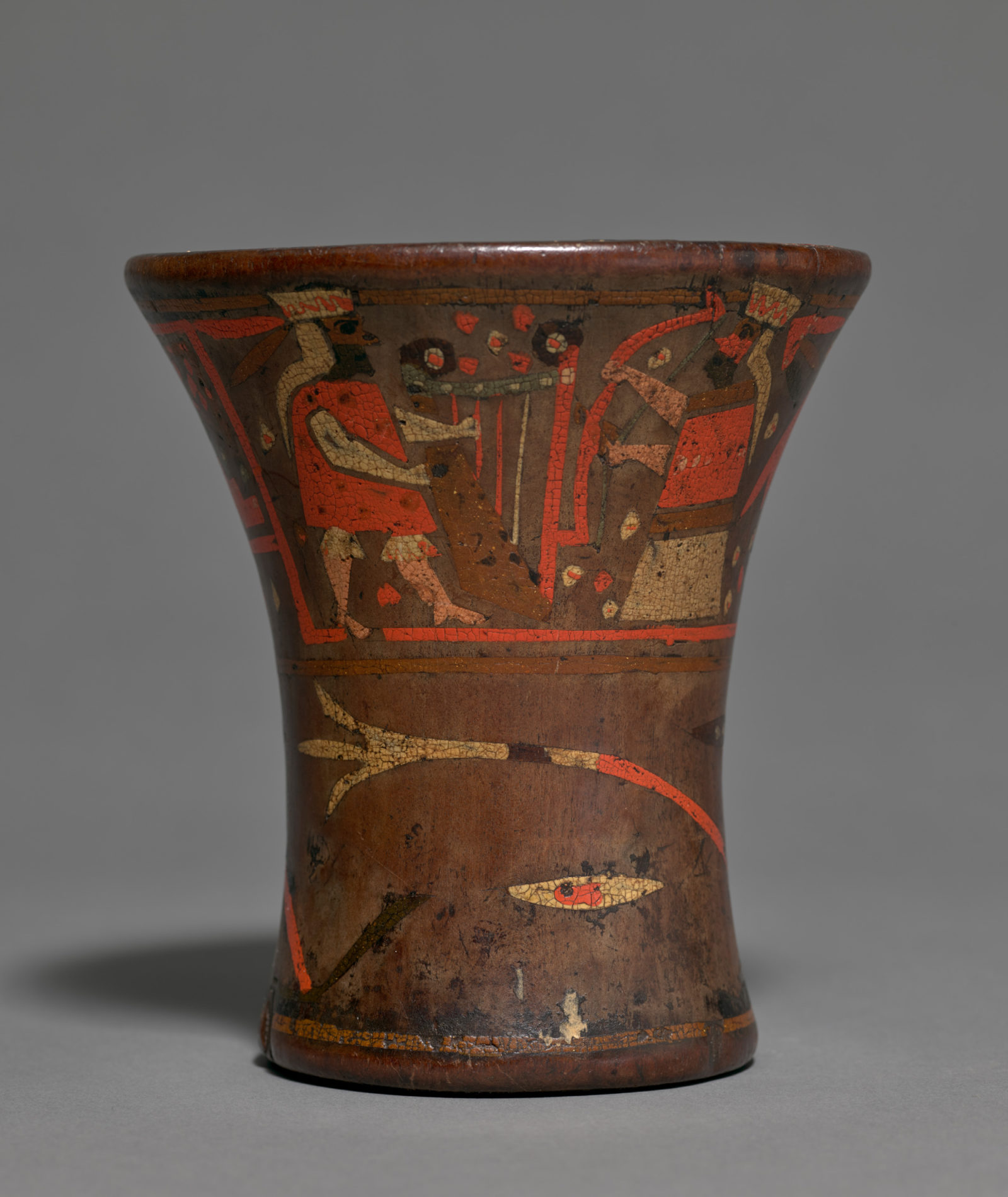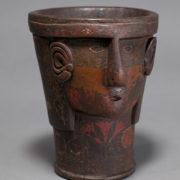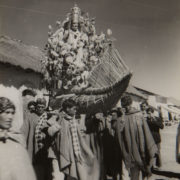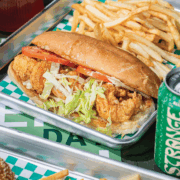“Enchanted: Visual Histories of the Central Andes” at The Menil Collection




 +5
+5 “Enchanted: Visual Histories of the Central Andes” at The Menil Collection
Drinking Cup (Kero) in the Form of Head, Possibly Representing a Person from the Forest (Anti or Chuncho), late 15th–18th century. Quechua. Colonial Period, Peru. Wood, natural resin, and pigments, 8 1/4 × 6 3/8 × 7 3/8 in. (21 × 16.2 × 18.7 cm). The Menil Collection, Houston. Photo: Paul Hester
“Enchanted: Visual Histories of the Central Andes” at The Menil Collection
Pierre Verger, “Untitled (The Sun Bursts Forth in a Few Hours to Light Up the Figure of Saint Peter, Fishing in a Lake Boat of Ancient Peruvian Model, Fiesta de San Pedro, Ichu, Puno, Peru)”, 1939–45. Gelatin silver print, 8 × 7 1/4 in. (20.3 × 18.4 cm). The Menil Collection, Houston. © Fundação Pierre Verger
“Enchanted: Visual Histories of the Central Andes” at The Menil Collection
“Enchanted: Visual Histories of the Central Andes” at The Menil Collection
“Enchanted: Visual Histories of the Central Andes” at The Menil Collection
“Enchanted: Visual Histories of the Central Andes” at The Menil Collection
“Enchanted: Visual Histories of the Central Andes” at The Menil Collection
“Enchanted: Visual Histories of the Central Andes” at The Menil Collection
“Enchanted: Visual Histories of the Central Andes” at The Menil Collection
Traveling in Peru, I knocked back a lot of beer. I was especially drawn to the brand Pilsen Callao. Which made it fun to see Peruvian keros (beer cups) in the Menil Collection’s fine exhibition “Enchanted: Visual Histories of the Central Andes” through November 14, 2021.
Keros are cups used for drinking maize beer (chicha) in Andean religious or political rituals. The practice of ceremonially brewing and drinking beer goes back to ancient times. Keros varied stylistically, the pre-Inca Wari peoples favored polychrome ceramic keros, while pre-Inca Chimú artisans excelled at ornate silver and gold keros. The Menil’s keros are wood carved and adorned with colorful images. An example of ritualistic use was the Inca religious ceremony, Inti Raymi, performed on the winter solstice to ensure the return of the Sun God, Inti. King Pachacútec lead a procession of bigshots and priests along the sacred path from Cuzco’s Temple of the Sun to the holy complex of Sacsayhuamán, where they sacrificed llamas and a few people, prayed to the sun, and drank corn beer in gold keros. Confident the sun would return, they traipsed back to Cuzco. In another example, the Chimú ritualistically downed beer and sacrificed children to the Moon god.
While rummaging through the collection, Menil curator Paul Davis came across photographs taken by French photographer Pierre Verger in Peru. Verger met John and Dominique de Menil in Buenos Aires in 1941, expressed his desire to return to the Andes to photograph religious festivals, and hit them up to underwrite his work. The de Menils agreed, and Verger (1905-1973) dedicated to them the book that helped make his reputation as a photographic anthropologist. As well, he gifted nearly 200 gelatin silver prints made from 1939 to 1945. Davis excitedly organized an exhibition with Verger’s never before exhibited photographs, other Andean artifacts in the Menil’s collection, and additional items borrowed from the Museum of International Folk Art in New Mexico. The show’s 67 objects – photographs, textile fragments, ceramics and more, trace Central Andean cultures from ancient times to the twentieth century.
Verger’s photographs of the monumental walls of Sacsayhuamán, and the interior of Machu Picchu’s Royal Tomb are straight-forward records of Inca archaeology. His photograph of a statue of Saint Peter being carried procession-style in a reed boat during the Fiesta de San Pedro, on the other hand, invites discussion. Reed boats, commonly seen along the Peruvian coast, have been used for nearly 3,000 years. The fisherman saint Peter, worshipped by fishing communities, slid into Peru with Pizzaro’s Catholicism. Not far removed from ritualistic prayer, dancing and boozing, and rowing the saint around in reed boats, are the mythical warrior Naymlap who invaded the Lambayeque Valley with reed boats, the legendary Taycanamo who arrived on reed rafts to begin the Chimú dynasty. Also, the gods who came out of Lake Titicaca to crank-up the Inca dynasty.
Before the Spanish came plundering, there was no written history. Ceramics, however, provide abundant information to supplement archaeological evidence. The pre-Inca Moche peoples made some of the finest and most informative pottery in existence. By studying battle scenes and sacrifices of captive warriors on Moche ceramics, historians can track Moche imperial expansion and military conquests. In equal measure, Moche pottery mirrors the sea’s bounty and maritime commerce. For instance, a ceramic vessel that illustrates reed rafts with cargo. The Menil’s exhibition includes a Moche stirrup-spouted ceramic vessel in the form of a sea lion from Peru’s North Coast.
Textiles are equally informative. Central Andean artisans made textiles from llama and alpaca wool, or cotton, to be worn as normal apparel, and for ceremonial purposes. A primary use was to wrap bodies and serve as grave goods. In Peru you can see open pits with mummies wrapped in textiles that are remarkably unfaded. Textile fragments in the Menil’s show are similarly vibrant. One rare and precious textile fragment, the Chimú Prisoner Textile, illustrates a maritime-themed sacrificial ritual. The Prisoner Textile is a fragment of a monumental 13th century textile that decorated the red adobe wall of a nobleman’s tomb at the Chimú imperial palace and pyramid complex Chan Chan. It depicts friezes of nude, neck-roped captives about to be sacrificed, and some disembodied heads. A related textile fragment decorated with sea animals helped scholars identify these prisoners as fishermen. Fish and other references to maritime activities on Chan Chan’s interior walls support this interpretation.
All those sacrifices didn’t keep the Chimú from being hammered by the Inca around 1470. The Inca stole Chan Chan’s gold and artisans and hauled them to Cuzco to make gold Inca gods, clueless of course that the Spaniard’s diseases and forced conversions were imminent. By the 18th century when a colonial-era Cuzco artist painted a religious icon painting of the patron saint of Cuzco, the Virgin of Bethlehem, seen in the exhibition, its details nodded to the indigenous past. The virgin’s garment borrows from Inca textiles and jewelry. Gold leaf on the canvas associates with the sun god Inti. The garment’s mountainous shape calls up earth mother goddess Pachamama, and links to the colorful costumes worn by dancers in Peruvian festivals.
The show has a blue and yellow feather mantle made by the Wari civilization, an imperial Central Andean culture that thrived from 600 to 1000 AD. Somewhat overlapping, the Nazca civilization on the south coast of Peru, was renowned for ceramics and elaborate textiles, and for its petroglyphs, the “Nazca lines.” I knew I would die in the single-prop plane used to see those lines. The Menil’s show has a Nazca round bottom polychrome ceramic bowl decorated with a toothy fish. Curator Davis said vessels attributed to the Nazca (ca. 100 BCE–800 CE) are the oldest Central Andean objects in the museum’s collection. He said the fish-like beings with razor sharp teeth depicted on the Menil’s round-bottom vessel are a common Nazca motif. They are thought to represent orcas, sharks, dolphins, or a composite of these and other sea creatures.









































